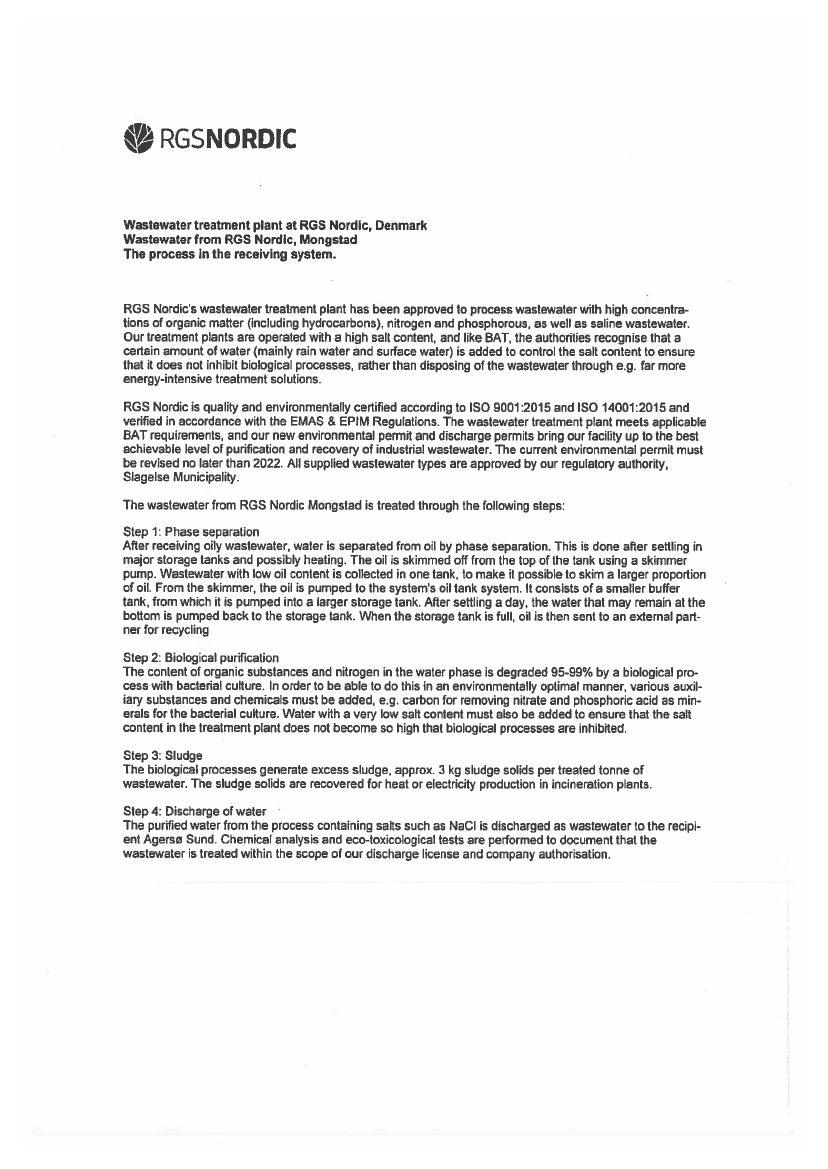
S)
RGSNORDIC
Wastewater treatment plant at RGS Nordic, Denmark
Wastewater from RGS Nordic, Mongstad
The process in the recelving system.
RGS Nordic’s wastewater treatment plant has been approved to process wastewater with high concentra
tions of organic matter (inciuding hydrocarbons), nitrogen and phosphorous, as well as salme wastewater.
Our treatment plants
are
operated
with
a high salt content, and like BAT, the authorities recognise that a
certain
amount of water (mainly min water and surface water) is added to control the salt content to ensure
that it does not inhibit biological processes,
rather
than disposing of the wastewater through eg. far more
energy-intensive treatnient soluflons.
RGS Nordic is quality and envimnmentally certified according to ISO 9001:2015 and ISO 14001 :2015 and
verified in accordance with the EMAS & EPIM Regulations. The wastewater treatment plant meets applicable
BAT requirements, and our new environmental
permit
and discharge permils bring our facility up to the best
achievable level of purification and recovery of industrial wastewater.
The
current environmental permit must
be revised no later than 2022. AlI supplied wastewater types are approved by our regulatory authority,
Slagelse Municipality.
The wastewater from RGS Nordic Mongstad is treated through the following steps:
Step 1: Phase separation
Atter receiving oily wastewater, water is separated from oil by phase separation. This is done after seifling in
major storage tanks and possibly heating. The oil is skimmed off from the top of the tank using a skimmer
pump. Wastewater with low oil content is collected in one tank, to make it possible to skim a larger proportion
of oil. From the skimnier, the oil is pumped to the system’s oil tank system. It ccnsists ofa smaller buffer
tank, from which it is pumped into a larger storage tank. After settling a day, the water that may remain at the
bottom is pumped back to the storage tank. When
the
stomge tank is full, oil is then sent to an external part
ner for recycling
Step 2: Biological purification
The content of organic substances and nftrogen in the water phase is degraded 95-99% by a biological pro
cess with bactedal culture. In order to be able to do this in an environmentally optimal manner, various auxil
iary substances and chemicals must be added, eg.
carbon
for removing nitrate and phosphoric acid as min
erals for the bactedal cufture. Water with a very low salt content must also be added to ensure that the salt
content in the treatment plant does not become so high that biological processes are inhibited.
Step 3: Sludge
The biological processes generate excess sludge, approx. 3 kg sludge solids per treated tonne of
wastewater. The sludge solids are recovered for heat or electricity production in incineration plants.
Step 4: Discharge of water
The purified water from the process containing saits such as NaCI is discharged as wastewater to the recipi
ent Agersø Sund. Chemical analysis and eco-toxicological tests are performed to document that the
wastewater is treated within the scope of our discharge license and company authorisation,